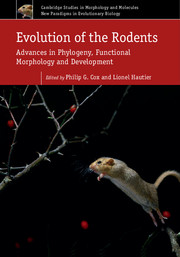Book contents
- Frontmatter
- Contents
- List of contributors
- Foreword
- 1 Rodentia: a model order?
- 2 A synopsis of rodent molecular phylogenetics, systematics and biogeography
- 3 Emerging perspectives on some Paleogene sciurognath rodents in Laurasia: the fossil record and its interpretation
- 4 Phylogeny and evolutionary history of hystricognathous rodents from the Old World during the Tertiary: new insights into the emergence of modern “phiomorph” families
- 5 The history of South American octodontoid rodents and its contribution to evolutionary generalisations
- 6 History, taxonomy and palaeobiology of giant fossil rodents (Hystricognathi, Dinomyidae)
- 7 Advances in integrative taxonomy and evolution of African murid rodents: how morphological trees hide the molecular forest
- 8 Themes and variation in sciurid evolution
- 9 Marmot evolution and global change in the past 10 million years
- 10 Grades and clades among rodents: the promise of geometric morphometrics
- 11 Biogeographic variations in wood mice: testing for the role of morphological variation as a line of least resistance to evolution
- 12 The oral apparatus of rodents: variations on the theme of a gnawing machine
- 13 The muscles of mastication in rodents and the function of the medial pterygoid
- 14 Functional morphology of rodent middle ears
- 15 Variations and anomalies in rodent teeth and their importance for testing computational models of development
- 16 The great variety of dental structures and dynamics in rodents: new insights into their ecological diversity
- 17 Convergent evolution of molar topography in Muroidea (Rodentia, Mammalia): connections between chewing movements and crown morphology
- 18 Developmental mechanisms in the evolution of phenotypic traits in rodent teeth
- 19 Diversity and evolution of femoral variation in Ctenohystrica
- 20 Morphological disparity of the postcranial skeleton in rodents and its implications for palaeobiological inferences: the case of the extinct Theridomyidae (Rodentia, Mammalia)
- Index
- References
9 - Marmot evolution and global change in the past 10 million years
Published online by Cambridge University Press: 05 August 2015
- Frontmatter
- Contents
- List of contributors
- Foreword
- 1 Rodentia: a model order?
- 2 A synopsis of rodent molecular phylogenetics, systematics and biogeography
- 3 Emerging perspectives on some Paleogene sciurognath rodents in Laurasia: the fossil record and its interpretation
- 4 Phylogeny and evolutionary history of hystricognathous rodents from the Old World during the Tertiary: new insights into the emergence of modern “phiomorph” families
- 5 The history of South American octodontoid rodents and its contribution to evolutionary generalisations
- 6 History, taxonomy and palaeobiology of giant fossil rodents (Hystricognathi, Dinomyidae)
- 7 Advances in integrative taxonomy and evolution of African murid rodents: how morphological trees hide the molecular forest
- 8 Themes and variation in sciurid evolution
- 9 Marmot evolution and global change in the past 10 million years
- 10 Grades and clades among rodents: the promise of geometric morphometrics
- 11 Biogeographic variations in wood mice: testing for the role of morphological variation as a line of least resistance to evolution
- 12 The oral apparatus of rodents: variations on the theme of a gnawing machine
- 13 The muscles of mastication in rodents and the function of the medial pterygoid
- 14 Functional morphology of rodent middle ears
- 15 Variations and anomalies in rodent teeth and their importance for testing computational models of development
- 16 The great variety of dental structures and dynamics in rodents: new insights into their ecological diversity
- 17 Convergent evolution of molar topography in Muroidea (Rodentia, Mammalia): connections between chewing movements and crown morphology
- 18 Developmental mechanisms in the evolution of phenotypic traits in rodent teeth
- 19 Diversity and evolution of femoral variation in Ctenohystrica
- 20 Morphological disparity of the postcranial skeleton in rodents and its implications for palaeobiological inferences: the case of the extinct Theridomyidae (Rodentia, Mammalia)
- Index
- References
Summary
Introduction
Ground squirrels of the genus Marmota are known for their ability to tolerate bitterly cold climates, which they in part accomplish with their exceptional ability to hibernate for as much as eight months a year (Armitage et al., 2003). Most of the 15 living species are associated with montane habitats, and those that are not, like the North American woodchuck (Marmota monax) and the eastern European and central Asian bobak (M. bobak) inhabit regions with strongly seasonal climates and often bitterly cold winters (Armitage, 2000) (Figure 9.1). All marmots construct burrows, which can be more than one metre deep even in comparatively mild climates and as much as seven metres deep in the harsh climates of the Himalayas (Barash, 1989). During the cold phases of the last half of the Quaternary the fossil record demonstrates many marmots inhabited periglacial environments (Zimina and Gerasimov, 1973; Kalthoff, 1999). For these reasons, marmots are sometimes considered to be a quintessentially Quaternary clade, specialists on the cold variable climates that are unique to the past 2.6 million years of Earth's history. The world in which they originated, however, was very different; a warmer one in which there were no tundra biomes, no glacial–interglacial cycles, and no permanent ice cover in the Northern Hemisphere. In this chapter, we review the fossil and phylogenetic history of marmots, the palaeoenvironments in which they originated, and their relationship to glacial–interglacial cycles to better understand the contexts in which the specializations of this unique clade of rodents arose.
The Quaternary, the current geological period, is defined by the onset of permanent ice sheets in the Northern Hemisphere 2.58 million years ago and is by far the coldest period since the extinction of the last non-avian dinosaurs 65 million years ago (Zachos et al., 2001; Gibbard et al., 2010).
- Type
- Chapter
- Information
- Evolution of the RodentsAdvances in Phylogeny, Functional Morphology and Development, pp. 246 - 276Publisher: Cambridge University PressPrint publication year: 2015
References
- 8
- Cited by



